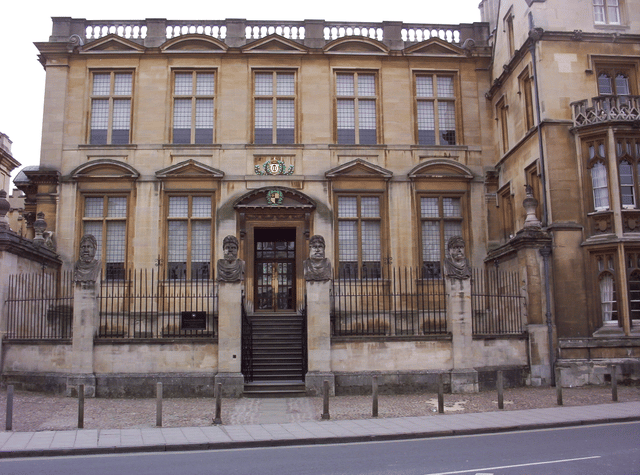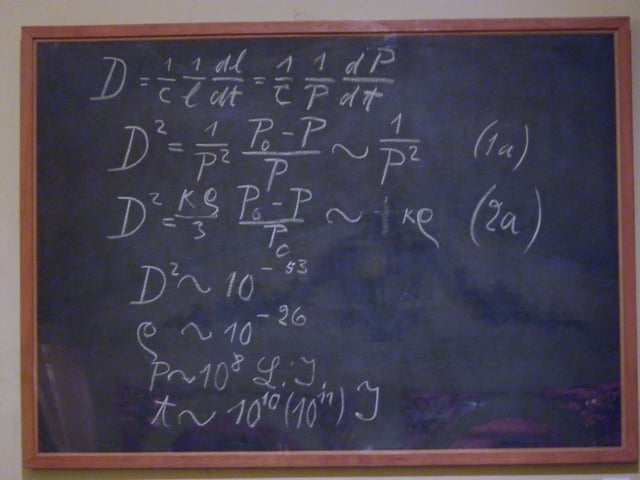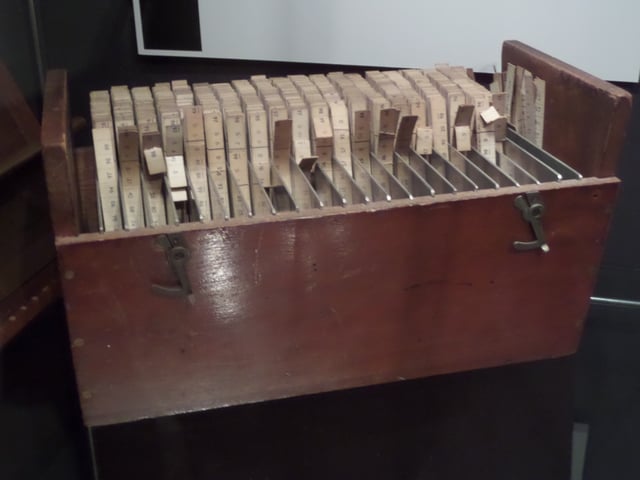Museum of the History of Science, Oxford

Museum of the History of Science, Oxford

| Established | 1683 (as Ashmolean Museum) 1924 (as Museum of the History of Science) |
|---|---|
| Location | Broad Street, Oxford, England |
| Coordinates | 51°45′16″N 1°15′19″W [12] |
| Type | University museum of the history of science |
| Visitors | 176,757 (2018)[1] |
| Director | Silke Ackermann |
| Website | History of Science Museum [13] |
The History of Science Museum in Broad Street, Oxford, England, holds a leading collection of scientific instruments from Middle Ages to the 19th century. The museum building is also known as the Old Ashmolean Building to distinguish it from the newer Ashmolean Museum building completed in 1894. The museum was built in 1683, and it is the world's oldest surviving purpose-built museum.
The museum is open to the general public every afternoon except Mondays, with free admission.
| Established | 1683 (as Ashmolean Museum) 1924 (as Museum of the History of Science) |
|---|---|
| Location | Broad Street, Oxford, England |
| Coordinates | 51°45′16″N 1°15′19″W [12] |
| Type | University museum of the history of science |
| Visitors | 176,757 (2018)[1] |
| Director | Silke Ackermann |
| Website | History of Science Museum [13] |
History
Built in 1683 to house Elias Ashmole's collection, it was the world's first purpose-built museum building and was also open to the public. The original concept of the museum was to institutionalize the new learning about nature that appeared in the 17th century and experiments concerning natural philosophy were undertaken in a chemical laboratory in the basement, while lectures and demonstration took place in the School of Natural History, on the middle floor. Ashmole's collection was expanded to include a broad range of activities associated with the history of natural knowledge and in 1924 the gift of Lewis Evans' collection allowed the museum further improvement, becoming the Museum of the History of Science and appointing Robert Gunther as its first curator.
Collections and exhibitions

Einstein's Blackboard, used by Albert Einstein in a 1931 lecture in Oxford.
The collection and the building itself now occupies a special position in the study of the history of science and in the development of western culture and collecting. One of the most iconic objects in the collection is Einstein's Blackboard[2] that Albert Einstein used on 16 May 1931 in his lectures while visiting the University of Oxford, rescued by dons including and E. J. Bowen and Gavin de Beer.[3]
The current collection contains around 18,000 objects from antiquity to the early 20th century, representing almost all aspects of the history of science and is used for both academic study and enjoyment by the visiting public. The museum contains a wide range of scientific instruments, such as quadrants, astrolabes (the most complete collection in the world with c.170 instruments), sundials, early mathematical instruments (used for calculating, astronomy, navigation, surveying and drawing), optical instruments (microscopes, telescopes and cameras), equipment associated with chemistry, natural philosophy and medicine, and a reference library regarding the history of scientific instruments that includes manuscripts, incunabula, prints and printed ephemera, and early photographic items.
The museum shows the development of mechanical clocks. Lantern clocks and longcase clocks are exhibited in the Beeson Room, named after the antiquarian horologist Cyril Beeson (1889–1975)[4] who gave his collection to the museum. Early turret clocks are exhibited above the stairs from the basement to the raised ground floor.
The museum is also home to the Rochester Avionic Archive, which includes a collection of avionics that originated with the Elliot Brothers, but also includes pieces from Marconi and BAE Systems.[7]
Curators

Beevers–Lipson strips,[8] part of the Crystals exhibition in 2014, used by Nobel Prize winner Dorothy Hodgkin for crystallography calculations at Oxford
R. T. Gunther (1924–40)
F. Sherwood Taylor (1940–45, temporary; 1945–50)
C. H. Josten (1950–64; 1964–94, emeritus)
F. R. Maddison (1964–94)
J. A. Bennett (1994–2012)
Stephen Johnston (acting director, 2012–14)
Silke Ackermann (2014 onwards)
See also
Dr Jim Bennett, the museum's former Keeper/Director (retired in 2012)
Dr Silke Ackermann, the museum's Director (from 2014)
Oxford University Scientific Society
Whipple Museum of the History of Science, the equivalent institution at the University of Cambridge
Ashmolean Museum
